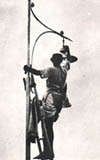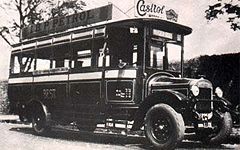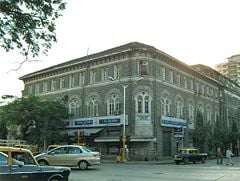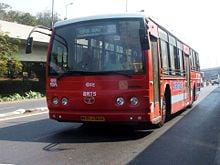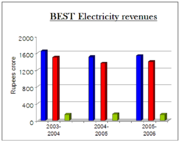Brihanmumbai Electricity Supply and Transport
- "B.E.S.T." redirects here.
| BEST Undertaking | |

| |
| Type | Autonomous State-owned enterprise |
|---|---|
| Founded | Mumbai (1873) |
| Headquarters | Mumbai, India |
| Key people | Uttam Khobragade, General Manager |
| Industry | Public transport, Electricity |
| Products | none |
| Revenue | |
| Employees | 44,000 (2005)
|
| Website | www.bestundertaking.com
|
The BEST (Marathi: बृहन्मुंबई विद्युतपुरवठा आणि परिवहन उपक्रम / बेस्ट) or the Brihanmumbai Electricity Supply and Transport signifies Mumbai's public transport service and electricity provider. The government-owned organization, set up in 1873, operates one of India's largest fleets of buses. Originally setup as a tramway company, it branched out into supplying electricity to the city in 1905, and later into operating buses in 1926. The city's municipality runs BEST as an autonomous body.
The bus transport service covers the entire city and also extends its operations outside city limits into neighboring Navi Mumbai, Thane and Mira-Bhayandar. In addition to buses, it also operates a ferry service in the northern reaches of the city. The electricity division of the organization constitutes one of the few electricity departments in India to garner an annual net profit. Until 1995, BEST stood for Bombay Electricity Supply and Transport. After the name of the city formally changed from Bombay to Mumbai, that also reflected the adjustment to Brihanmumbai, which means "Greater Mumbai."
BEST stands as an example of a company, and a government company at that, standing on its own feet with the backdrop of living under colonial rule, and attaining an admirable level of success. Begun in 1873 as a tram company, then providing bus service in 1926, BEST emerged as the largest provider of bus service to a metropolitan area in India. Helping to build that success, the company entered the electricity generating and providing business, successfully operating and building a previously private business.
History
Origins
An American company, which applied for a license to operate a horse-drawn tramway system, first put forward the idea of a mass public transport system for Mumbai in 1865. Although granting a license, the project never launched, owing to the prevailing economic depression in the city. The end of the American Civil War, during which Bombay had made vast strides in its economy by supplying cotton and textiles to the world market, represented the reason for the economic downturn.
Later, on November 11 1871, a notice in the Times of India newspaper put by the Bombay Omnibus Service, proposed to set up a bus service between Malabar Hill and Fort. The proposed monthly pass fare of thirty pounds proved too expensive, leading to a prompt abandoning of the tender.[1]
The tram company
The birth of the BEST dates to 1873, with the setting up of the Bombay Tramway Company Limited, which received a license to operate trams in the city. The Bombay Municipal Corporation (BMC) received the right to purchase the company after twenty-five years, or after seven years thereafter. In 1874, the government enacted the Bombay Tramways Act after the Municipality and the Company formally signed the contract to start the transport system.
On May 9, 1874, the first horse-drawn carriage made its début in the city, plying on the Colaba–Pydhone via Crawford Market, and Bori Bunder to Pydhonie via Kalbadevi routes. The initial fare cost three annas (15 paise), without tickets issued. As the service became increasingly popular, the fare reduced to two annas (10 paise). Later that year, the company issued tickets for the first time, to curb the increasing fareless travel.
In 1899, the company applied to the BMC, for operation of electrically operated trams. Due to the high investment required, the company suggested that the BMC should waive its right to take over the tramways, scheduled to take place in 1901 according to the contract signed in 1874. After due deliberations, the BMC decided to take over the company. The takeover created several legal problems, leading to the foundation of a new public company, the Bombay Electric Supply & Tramways Company Limited, which bought out the Bombay Tramway Company in 1905.[1]
That same year, the company also acquired the British Electric Traction Company, which owned a 1,100 hp (820 kw) generator and serviced 107 consumers. Two years later, the first electric tram debuted in the city. Later that year, a 4,300 kw steam power generator was commissioned at Wari Bunder. In 1916, power purchase from the Tata Power group, a privately owned company, started and by 1925, Tata provided all power generation.[2]
Advent of buses
Since 1913, the company had been pondering over starting a motorized bus service. The high accident rate for a similar service in London argued against its introduction. Finally, after years of debate, the company came to a decision on February 10, 1926, to start a bus service later that year. On July 15, 1926, the first bus service in India started on three routes. Despite stiff opposition and protests by taxi-drivers, the service ran without a hitch, transporting six lakh (600,000) passengers by the end of that year. The following year the number had increased to 38 lakhs (3.8 million). The trams meanwhile, due to their lower fares, became a poor man's transport.
The Indian independence movement's call for mass non-violent strikes and general civil disobedience, led to regular service disruptions, leading to the company incurring huge losses in 1929. The next year proved a particular bad year for the company in the wake of the Great Depression. To remain solvent, the company decided to introduce discounted fares for short routes, and increase its coverage to the northern portions of the city. In 1937, the introduction of double-decker buses proved extremely popular.
World War II brought with it the rationing of fuel and a shortage of tires. The increasing costs of owing a car forced many to switch to using the bus service. Despite huge losses, the company diligently plied its buses and trams to cater to the residents of Bombay.[3]
The BEST Undertaking
After World War II, and India's independence, the BMC took over the management of the company on August 7, 1947, with the company renamed "The BEST Undertaking."[4]
As the company grew post-independence, it increased its fleet from 242 to 582 buses over the next decade. In 1949, it took over the Bandra Bus Company, which used to ply buses in the suburbs.[5] In 1951, the electricity division switched over from direct current (DC) to the more efficient alternating current (AC). The company launched its services in the eastern suburbs in 1955. That year, the Undertaking and private operators went to court, with the BEST asking for a complete closure of the private companies. The case dragged on for four years before the Supreme Court of India granted the organization a complete monopoly over bus services in the Greater Bombay area. In 1964, due to high operational costs and poor public support, its long-running tram services terminated.[6]
The company achieved the status of being the first company in the country to issue computerized billing in 1974. In 1994, the company introduced electronic meters, in a move to replace the less accurate electric meters. Following a Supreme Court directive, the company has been gradually phasing out old buses and introducing new buses which comply with the Euro II pollution control standards.[7]
Transport
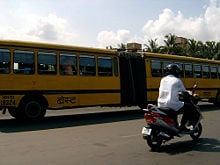
As of 2006, the BEST runs a total of 3,400 buses,[8] ferrying 4.5 million passengers over 340 routes, and has a workforce strength of 38,000, which includes 22,000 bus drivers and conductors (this comes to an average of 11.2 employees per bus). Single decker buses make up the bulk of the fleet, followed by the double-decker buses and air-conditioned buses, which ply on select routes. Following court directives, the company launched limited 'disabled friendly' buses on exclusive routes in 2005 that have low ramps and space for wheelchairs.[9] The company also plies vestibule buses on the city's two express highways. Those buses, introduced in 1997, have a capacity of 110 passengers.[10] All buses have route numbers tagged with its corresponding destination, displayed in the front (in Marathi) and on the side (in English).
Routes fall into four categories: Ordinary, Limited, Express and Special. Ordinary routes run most often, with buses on those routes stopping at all stops. A white route number on a black background identify buses plying on those routes.
Buses on Limited routes stop only at important places and skip all the minor stops in between on high volume routes. They have a marginally higher fare, identified by the route number in red on a white background. The route number ends with LTD.
Special routes ply on select routes covering train terminuses and the central business districts. Those routes have a fare marginally higher than the "Limited" routes, identified by the route number in white on a red background.
Express routes service long distance intra-city routes, and have the same fares as the Special routes, but with fewer stops. Those buses have route numbers indicated in red on a yellow background. They skip the flyovers, unlike other buses.
Air-conditioned buses fares cost a little over four times the fare of an 'Ordinary' route covering the same distance. Those buses have route numbers starting with A.
In June 2005, BEST decided to hire buses from private operators instead of procuring new buses to cut costs. Those buses look the same as a regular bus, but the private operators take care of the maintenance and salaries.[11] The BEST also plans to install GPS systems on all its buses, to monitor them in realtime. It also plans to reintroduce pre-paid smart cards along selected routes. They installed that service in 1998, but terminated it in 2000.[12] In August 2006, BEST buses also introduced pay-phone system and CCTVs on its buses.[13]
Besides buses, BEST also operates a ferry service (since 1981) in northern Mumbai, across the Manori Creek. The barges operate at regular intervals across the shallow creek linking Manori to Malad.
Terror attacks
The B.E.S.T bus service has suffered two bombings killing six people.
- December 6, 2002–Bomb goes off in a bus in Ghatkopar killing two
- July 28, 2003–Bomb goes off in a bus in Ghatkopar killing four
Electric department
Since 1926, the BEST has been sourcing its power from Tata Power, part of the Tata Group conglomerate. The power cables lay underground, reducing pilferage and other losses that plague most other parts of India. BEST supplies a nominal rating of power 3-phase, 50 Hz, 220/110 kV. Unlike the transport company, the electricity department services only the Mumbai City area, and excludes the suburbs. It provides power to over a million residential and commercial establishments and over 33,000 street lights within the city limits. As of 2000, BEST supplies a total of 700 MW, with a consumption of 3,216 GWh.[14]
The electricity department has 6,000 employees. The city has three 110 kV, twenty-two 33 kV and 22 kV substations. BEST has a distribution loss of around 10% (2001), among the lowest in India.
In 2003, the Electricity Act (2003) came into force, requiring electricity providers to generate at least 10% of their power through renewable sources. To comply with that act, BEST has been installing photovoltaic cells in each of its twenty five depots. They also plan to use solar power in gardens and street lighting where the demand is low. Another option being considered is the possibility of using the 7,000 metric tons of garbage disposed by the city on a daily basis, which can be potentially used to generate 350 MW of electricity.[15]
Organization
A General Manager, currently Uttam Khobragade, heads the company. An Assistant General Manager (Traffic Operations), assisted by the Chief Traffic Manager (Sr.), oversee the traffic department. The Chief Traffic Manager oversees the five BEST zones, each headed by a Traffic Manager. Each zone consists of five to six depots, overseen by an Assistant General Manager (Traffic Operation). A Traffic Superintendent or Assistant Traffic Superintendent heads each depot.[16]
A Deputy General Manager (Electric Supply) (DGM (ES)) heads the electricity department. An Assistant General Manager (Electric Supply) (AGM (ES)), assists him, directing planning, new projects, construction, street lighting, computer applications and the generation cell. The Chief Engineer—Electric Supply (CEES) manages material testing and the Standards, Meters and Relays, and the Review departments. Two Chief Engineer—Distribution (CED) officials direct the two administrative zones.[17]
The BEST enjoys a high degree of autonomy under the BMC; the latter approves its yearly budget and permits increases in bus fares when required. A body of seventeen Municipal Corporators from the ruling party in the BMC form the BEST Committee. The committee, headed by a Chairman, keeps a tab on the undertaking's daily operations.[18] The committee has a staggered two year term.
The "digitization project," wherein all underground cables, sub-stations, street lights and bus-stops will be tracked digitally through the geographical information system has entered the planning stage. Connecting all its electricity meters through a network, so that the readings can be taken remotely, and in realtime, thus obviating the need for monthly manual door-to-door inspection, has been undergoing planning.
Finances
In the financial year 2004–05, the company earned Rs. 1,514.22 crore[19] from its electricity department, and 839.18 crore from its transport department. Profits from its electricity department totaled Rs. 152.82 crore (US$35m), and losses in its transport department totaled Rs 212.86 crore ($48.8m), giving the company a net loss of Rs. 62.04 crore ($14.2m).
For the financial year 2005–06, BEST earned Rs. 1,540.13 crore ($352.92m) with a profit of 140.8 crore ($32.3m) from the electricity department alone. Its transport department earned 948.68 crore ($217.39m), with a loss of 140.30 crore ($32.26m). That gave it a net loss of Rs. 50 lakhs ($114,575).[20][21] Newer management techniques, such as retrenching of excess staff (494 till date),[18] and the closure of less patronized routes, have reduced the losses in recent years, from a high of Rs. 175 crore ($40.1m) in 2001.[22]
Daily earnings from its transport system totals Rs. 2 crore ($458,450). It collects Rs. 70 lakh ($160,450) worth of five rupee coins daily, Rs. 48 lakh ($110,000) worth of ten and twenty rupee notes, and Rs. 60 lakh ($137,535) worth of fifty rupee notes, through its fare collection system. That has led a unique situation wherein it has accumulated a surplus of short change. In July 2005, the company floated tender inquiries to fifty four banks to exchange the loose change, which totaled 4.67 crore ($1.07m). None of the banks sent in a single bid, some citing full vaults while others saying it would be unprofitable for low denominations, given security considerations.[23]
Though a government-owned company, BEST operates independently without any financial assistance from the BMC, or the state government.[18] BEST also earns revenues by way of advertisements on its buses and bus-stops, and through rent from offices on owned properties. The BEST, being a public utility company, must minimize profits by holding costs for electricity and bus fares. An increase, when effected, usually aims to curb losses due to inflation. BMC must grant permission before such an increase goes into effect.
Culture and awards
BEST has been a quintessential part of life in Mumbai. The red double decker buses, modelled on the Routemaster buses of London, constitute one of the defining characteristics of the city. When BEST decided to do away with the double-deckers for operational reasons recently, public protests and sentiment forced it to continue with the service. A move to color all its buses saffron from red in 1997 also drew in sharp criticism, resulting in the red color being retained. Bus drivers and conductors have come in for praise in the media for their service during the 2005 Mumbai floods, when they dropped all the stranded passengers safely at their respective destinations. The deluge rendered a total of 900 buses useless.
The organization has received the following awards for safety and management:[24]
- The prize for the second best production achievement by an urban transport body in the country for the year 1982.
- The second prize for production achievement in Urban Transport during the year 1984.
- A memento for the Administrative Report and Statement of Accounts of the Undertaking for the year 1983–84 awarded by the selection committee nominated by the Institute of Chartered Accountants of India.
- The first place and the Best production achievement award in the category of urban transport for the year 1986–87.
- National Productivity Award for the year 1991–92.
- Award for the best passenger-safety record for the year 1994.
- The prestigious award for the Best Passenger-Safety performance in Urban Transport in the whole country instituted by the Association of State Road Transport Undertaking (ASRTU) for the year 1995–96.
- International Road Safety Award for the year 2003.
See also
- Public transport in Mumbai
- Mumbai Suburban Railway
Notes
- ↑ 1.0 1.1 BEST Undertaking, Tram-Car Arrives. Retrieved October 12, 2006.
- ↑ BEST Undertaking, Electricity Arrives In Mumbai. Retrieved October 12, 2006.
- ↑ BEST Undertaking, Motor-Bus Appears. Retrieved October 12, 2006.
- ↑ BEST Undertaking, B.E.S.&T. Company. Retrieved October 12, 2006.
- ↑ BEST Undertaking, Progress Of The Bus Service. Retrieved October 12, 2006.
- ↑ BEST Undertaking, Alternative modes of Transport. Retrieved October 12, 2006.
- ↑ BEST Undertaking, Electric Supply. Retrieved October 12, 2006.
- ↑ BEST Undertaking, Composition of Bus Fleet. Retrieved October 12, 2006.
- ↑ DNA, Now, BEST buses for the disabled, Daily News & Analysis. Retrieved October 12, 2006.
- ↑ BEST Undertaking, Articulated Single Deck Bus. Retrieved October 12, 2006.
- ↑ Olav Albuquerque, BEST to hire buses from private operators, Times of India 7 (2005).
- ↑ Ashley D'Mello, BEST will have to wait to become smart, Times of India July 2, 2005.
- ↑ DNA Correspondent, BEST makes a smart move. Retrieved October 12, 2006.
- ↑ Maharashtra Electricity Regulatory COmmission, Electricity. Retrieved October 12, 2006.
- ↑ Olav Albuquerque, Short of funds, BEST looks to solar power, Times of India July 8, 2005.
- ↑ BEST Undertaking, Organisational Setup. Retrieved October 12, 2006.
- ↑ BEST Undertaking, Organisational Setup. Retrieved October 12, 2006.
- ↑ 18.0 18.1 18.2 Girish Kuber, Road warrior: City’s bus service proves it’s BEST, Economic Times. Retrieved October 12, 2006.
- ↑ 1 crore = 10 million. (See Indian numbering system). Rs 1 cr. = 230,000 US$ approx. Exchange rate: Rs. 43.6 = 1 US$ as of 2005-08-27.
- ↑ 1 lakh = 100,000.
- ↑ BEST Undertaking, Finance. Retrieved October 12, 2006.
- ↑ Joseph Manu, May the Best Man Win, Times of India August 21, 2005.
- ↑ Olav Albuquerque, You could now approach BEST for some loose change, Times of India, July 6, 2005.
- ↑ BEST Undertaking, Awards. Retrieved October 12, 2006.
ReferencesISBN links support NWE through referral fees
- Baker, Judy L. Urban Poverty and Transport The Case of Mumbai. Washington, D.C.: World Bank, 2005.
- Dalvi, M. Q., and P. G. Patankar. "Financing a Metro Rail Through Private Sector Initiative The Mumbai Metro." Urban Transport Policy: A Sustainable Development Tool. 1998. OCLC 40626499
- Dhakras, Bhairavi. Study of Parameters in the Development of Sustainable Transportation System A Case Study of Mumbai, India. Thesis (M.S.V.)—University of Toledo, 2004. OCLC 58434371
- Tiwari, P., and T. Kawakami. "Designing Effective Transportation Policies in Mumbai." Rivista Internazionale Di Economia Dei Trasporti 30(1) (2003): 61-89.
- Verghese, J. T., and J. Jansky. "The Institutional Framework for Urban Transport Projects in Developing Countries Case Study of Mumbai, Bombay, India." Urban Transportation and Environment,2000. OCLC 52149907
External links
All links retrieved November 20, 2023.
- BEST Undertaking – Official site of the BEST.
- Road warrior: City's bus service proves it's BEST Economic Times August 15, 2005.
Credits
New World Encyclopedia writers and editors rewrote and completed the Wikipedia article in accordance with New World Encyclopedia standards. This article abides by terms of the Creative Commons CC-by-sa 3.0 License (CC-by-sa), which may be used and disseminated with proper attribution. Credit is due under the terms of this license that can reference both the New World Encyclopedia contributors and the selfless volunteer contributors of the Wikimedia Foundation. To cite this article click here for a list of acceptable citing formats.The history of earlier contributions by wikipedians is accessible to researchers here:
The history of this article since it was imported to New World Encyclopedia:
Note: Some restrictions may apply to use of individual images which are separately licensed.

